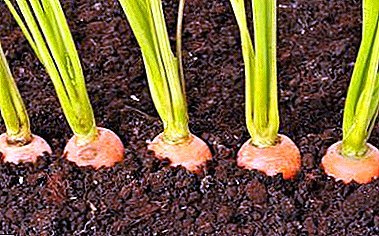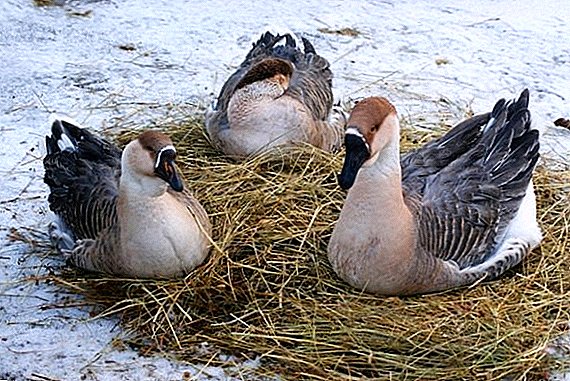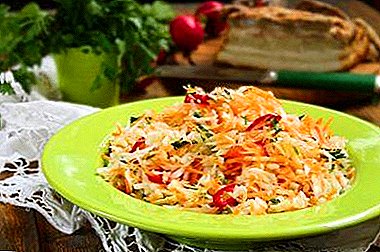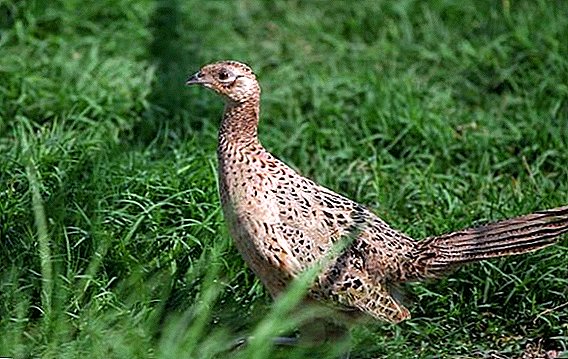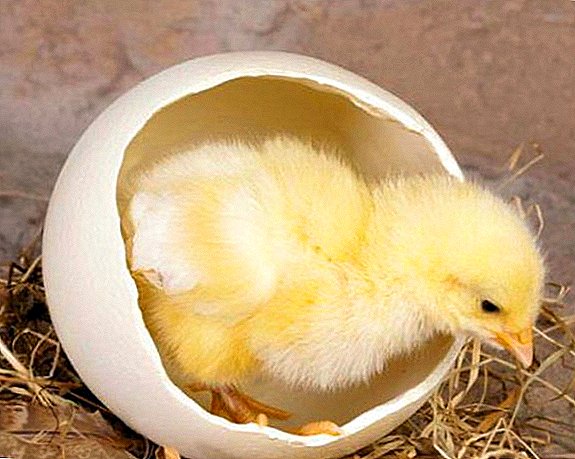 In many household plots, one can hear the discordant hubbub: a hen whimsy, a quack of ducks, a giggle of geese, and a scream of turkeys. In order not to buy young birds every spring, the owner is more profitable to take the bird in his farm. To do this, you need to purchase a device such as an incubator.
In many household plots, one can hear the discordant hubbub: a hen whimsy, a quack of ducks, a giggle of geese, and a scream of turkeys. In order not to buy young birds every spring, the owner is more profitable to take the bird in his farm. To do this, you need to purchase a device such as an incubator.
let's consider incubators "Perfect hen"which are made by Novosibirsk firm "Bagan". Let us study the advantages and disadvantages of this device, we will describe in detail how to use it.
general description
Incubator "Perfect hen" its parameters are more suitable for small poultry houses. With its help it is easy to breed chicks of such domestic birds as:
- chickens and geese;
- ducks and turkeys;
- quails, ostriches, parrots and pigeons;
- pheasants;
- swans and guinea fowls.
The incubation device is made of dense foam, has a small size and low weight. The heating plates are fixed on the upper cover of the incubator, which allows the masonry to be heated evenly.
Did you know? Does the chicken breathe in the shell? Thick, thick shells are actually permeable to gases. Oxygen enters the embryo through the porous structure of the shell, moisture and carbon dioxide are removed. On a chicken egg you can count more than seven thousand pores, most of which are located from the blunt end.
Popular models
Novosibirsk company "Bagan" produces incubators "Ideal hen" in 3 versions:
- model IB2NB - C - is equipped with an electronic temperature controller, 35 chicken eggs can be laid in it at a time, the coup is carried out manually;
- IB2NB -1Ts model - besides the electronic temperature controller there is a mechanical lever for turning. Capacity for 63 eggs is provided. By the way, the user can increase the space for laying eggs from 63 pieces to 90 pieces. To do this, remove the rotator from the incubator and rotate them manually;
- model IB2NB -3Ts - has all the characteristics of the first two and additions in the form of a microcontroller and automatic bookmark flip (every 4 hours).
 The remaining models differ from the first three only in the capacity of the device and their power consumption. The mass of the device varies in each model.
The remaining models differ from the first three only in the capacity of the device and their power consumption. The mass of the device varies in each model.Specifications
The incubation device "Ideal hen" is an inexpensive device, the technical characteristics of which correspond to the fact that the device will be used at home:
- it has protection against water and current (Class II);
- using a temperature relay, you can adjust the temperature (+ 35-39 ° C);
- accuracy of maintaining the temperature in the device to 0.1 ° C;
- the device operates at 220 volts (mains) and 12 volts (battery);
- Incubator parameters depend on the model: width - min 275 (max 595) mm, length - min 460 (max 795) mm and height - min 275 (max 295) mm;
- the weight of the device also depends on the chosen option and ranges from 1.1 kg to 2.7 kg;
- capacity of the device - from 35 pieces to 150 pieces (depends on the model of the incubator).

Learn more about the features of growing: ducklings, turkeys, poults, quails, chickens and goslings in the incubator.
The company gives a guarantee for the first year of operation of the device and a certificate. Provides a total operating life of up to 10 years. Included with the incubator is a user manual and additional equipment:
- egg grid;
- plastic grid for eggs;
- pallet-tray (size according to the model);
- device for turning eggs (according to the model);
- thermometer.
Pros and cons of the "Ideal hen"
The main advantages of the domestic incubator "Ideal hen" include:
- small weight of the device: it can be easily rearranged and transferred to one person without any help;
- the case is made of dense foam, has high strength and withstands mechanical pressure up to 100 kg;
- uniform distribution of heat, which occurs due to the wide heating plates fixed on the incubator lid;
- low power consumption;
- constant control and maintenance of the set temperature by the thermostat;
- the ability to connect the device from the network and from the battery (which is important when power outages);
- the presence of an automatic coup incubation bookmarks;
- the ability to visually inspect the bookmark without opening the incubator (through the window);
- convenient temperature controller located on the outside of the instrument cover.
There are a few shortcomings in the “Ideal hen”:
- the black-painted numbers on the electronic scoreboard are hard to see at night: you need either additional window illumination, or other color numbers (green, red);
- the incubator should be installed in such a place that air circulation (table, chair) would pass unhindered at the bottom of the device;
- The foam body reacts poorly to direct sunlight.
Did you know? The chicken has a much wider viewing angle than a person’s - because his eyes are located on the sides of his head! The chicken sees what is happening not only in front of him, but also behind him. But in such a special vision, there are also disadvantages: there are areas for the chicken that he cannot see. In order to see the missing part of the picture, chickens often throw their heads to the side and upwards.
How to prepare an incubator for work
Before laying a batch of eggs for incubation, you need to carry out the necessary activities:
- Clean the inside of the device from debris (fluff, shell) remaining from the previous incubation.
- Wash with warm water and laundry soap, adding disinfectants to the cleaning solution.
- Boiled water is poured into a clean appliance (boiling is obligatory!). For filling with water, grooves are provided on the bottom of the device. Pour no higher than the sides. If the room is very dry, then you need to pour water into all four cavities, if indoors the raw water is poured only into two (located under the heater) cavities.
- It is necessary to check that the probe of the thermal sensor hanging over the eggs does not touch their shell.
- The incubator is covered with a lid, the thermostat and the turning mechanism are turned on (if it is provided in this model) and heated to the temperature recommended by the manufacturer.
 The incubator is ready to receive material for incubation.
The incubator is ready to receive material for incubation.Proper feeding: chickens, goslings, ducklings, broilers, quails and musk ducks from the first days of life - the key to successful breeding.
Preparation and laying eggs
The selection of material for incubation is a very important stage for obtaining a good result.
Requirements:
- eggs must be fresh (no older than 10 days);
- the temperature at which they are stored until they are placed in the incubator should not fall below +10 ° C, deviations in any direction adversely affect the viability of the fetus;
- have an embryo (installed after checking on the ovoskop);
- dense, uniform (without overflows) shell structure;
- Before incubation, the shell should be washed in warm water with soap or in a pale pink solution of potassium permanganate.

Check on the Otoscope
All eggs before incubation should be checked for the presence of the embryo. In this poultry farmer will help such a device as an ovoskop. Ovoskop can be both factory and assembled at home. Ovoskop will show whether there is a germ in the egg, whether the shell is uniform, the size and location of the air chamber.
How to make an ovoscope at home with your own hands:
- Take any cardboard or plywood box of small size.
- An electric light bulb is installed inside the box (to do this, a hole must be drilled into the side of the box for an electric lamp cartridge).
- An electric cord and a plug for switching the bulb into the network are connected to the bulb holder.
- On the lid that covers the box, cut a hole in shape and size of the egg. Since eggs are different (goose - large, chicken - small), the hole is made on the largest egg (goose). In order for small eggs not to fall out into too large a hole, several thin wires are criss-crossed on it as a substrate.

View germs held in a dark room! Before starting work we turn on the light bulb in the network (the box is lit from the inside). An egg is laid on the hole in the lid of the box and translucent to check for suitability.
Did you know? It has been argued that the temperature at which chickens were bred affects their future sex. This is not true, because the usual ratio of hatched chickens and cockerels is 50:50.
Thermostat adjustment
The display window on the outer lid of the device indicates the temperature inside the incubator. You can set the desired temperature using two buttons (less or more) located at the display. One click of the desired button is a step of 0.1 ° C. At the beginning of work, the temperature is set for the first day of incubation, after which the device is left for half an hour to warm up and set temperature drops to constant.
Temperature range for incubating chicken eggs:
- 37.9 ° C - from the first to the sixth day of incubation;
- from day 6 to the fifteenth - the temperature is gradually reduced (without sharp jumps) to 36.8 ° C;
- From the 15th to the 21st day, the temperature slowly and evenly decreases daily to 36.2 ° C.
When you open the top cover of the device, you need to temporarily turn off the thermostat, since it is triggered by the flow of fresh, cool air by lowering the temperature inside the incubator. Terms of incubation of various breeds of birds:
- hens - 21 days;
- geese - from 28 to 30 days;
- ducks - from 28 to 33 days;
- pigeons - 14 days;
- turkeys - 28 days;
- swans - from 30 to 37 days;
- quail - 17 days;
- ostriches - from 40 to 43 days.
The necessary data on the breeding of different breeds of poultry can be found in the special literature.
Egg selection
What should be a good, suitable for incubation egg:
- the air chamber must be exactly in the blunt part, without displacement;
- all eggs are desirable to take medium size (this will give a one-time naklev);
- classical form (elongated or too round are not suitable);
- no damage to the shell, stains or nodules on it;
- with good weight (52-65 g);
- with a clearly visible O-shaped embryo and a dark speck inside;
- germ size 3-4 mm in diameter.
 Unsuitable for incubation:
Unsuitable for incubation:- eggs in which two yolks or yolks are not at all;
- crack in the yolk;
- displacement of the air chamber or lack thereof;
- no germ.
If the poultry farmer has paid enough attention to the selection of eggs, then a healthy young bird will hatch with a small, soft tummy and a healed navel.
Egg laying
Before laying the eggs in the incubator, they need to be marked with a simple pencil with a soft rod: put the number "1" on one side, mark the second flank with the number "2". This will help the breeder to control the simultaneous turning of the eggs.  Since the incubator is preheated and the thermostat is set to the desired temperature, the poultry farmer can only bookmark. It is necessary to disconnect the thermostat from the network and open the lid of the device. The incubation material is placed on a plastic grid-substrate so that the number "1" on each egg is on top. The lid of the device is closed and the thermostat is connected to the network.
Since the incubator is preheated and the thermostat is set to the desired temperature, the poultry farmer can only bookmark. It is necessary to disconnect the thermostat from the network and open the lid of the device. The incubation material is placed on a plastic grid-substrate so that the number "1" on each egg is on top. The lid of the device is closed and the thermostat is connected to the network.
Some tips on incubation:
- It is necessary to lay a batch after 18:00, this will allow to push the mass up to dawn (during the day it is easier to control the hatching of chicks).
- Owners of models with an automatic laying of the laying need to lay eggs for incubation with a blunt tip to the top.
- It is possible to provide simultaneous egg laying by laying eggs into the device in turn - the largest at once, then the smaller ones and at the end the smallest ones. It is necessary to observe the four-hour interval between the tabs of lots of different-sized eggs.
- The temperature of the water poured into the pan should be + 40 ... +42 ° С.
Important! The incubator should turn over several times during the day, with an interval of at least 4 hours and no more than 8 hours between treatments.
Rules and process of incubation
During the entire incubation process, the poultry farmer needs to observe the device. Performing any actions inside the incubator, you need to disconnect from the mains plug electrical power and temperature controller. 
What activities may have to hold:
- Add warm water to the depressions specially provided for it, as necessary (pour water into the incubator, without taking out the eggs laid in it, through the cage pan);
- change the temperature in accordance with the temperature schedule of incubation;
- if the device does not provide an automatic coup function, then the poultry farmer does it manually or using a mechanical device.
Manual coup
In order for eggs not to be damaged in the process of turning, they are recommended to be rotated by a shift method - palms are put on a row of eggs and a shift is made in one sliding movement, as a result of which instead of the number "1" the number "2" becomes visible.
Mechanical coup
In models with a mechanical flip - the eggs fit into the cells of the metal grid. In order to turn them around, the grid is shifted a few centimeters, until the eggs complete a turn and the number "1" is replaced by the number "2".
Automatic coup
In models with automatic flip tab is turned over without human intervention. The device performs such an action six times a day. The intervals between coups are 4 hours. It is recommended that you manually take the eggs from the central rows once a day and swap them with those located in the outermost rows. Supercooling of the laid eggs is strictly not allowed. When the manual overturn procedure is completed, the device is covered with a lid and plugged into the network. After 10-15 minutes, the temperature is restored to the set value on the display.
Important! At the end of the 15th day of incubation, the eggs do not turn over! In the morning of the 16th day, you must turn off the PTZ device in those devices where it is provided for automatically.
The development of embryos is checked on the ovoscope twice during the incubation:
- After a week of incubation, the material appears through the ovoscope, at this time the dark area in the yolk should be clearly visible - this is a developing embryo.
- The second procedure is carried out in 12-13 days from the beginning of the laying, the ovoscope should show a complete darkening within the shell - this means that the chick is developing normally.
- Eggs, in the development of which something went wrong - they will remain bright when they are scanned on an ovoscope, they are called “talkers”. The chick does not hatch out of them, they are removed from the incubator.
- The destruction of the shell of chicks occurs in a thicker (blunt) part of the egg - where the air chamber begins.
- If, violating the time of incubation, the chicks hatched one day earlier than expected, then the owner of this device should set the incubation temperature lower by 0.5 ° C for the next batch of incubation. If the chicks hatched a day later, the temperature should be increased by 0.5 ° C.

Why sick chickens hatched:
- the reason for the removal of non-viable, weak chickens are poor-quality eggs;
- if the incubation temperature was not observed, the hatched chickens will be “dirty”; at a temperature lower than that relied on, the internal organs and navel of the birds will be green.
- if from 10 to 21 days the humidity inside the device was high, the chickens start to hatch in the middle of the shell.
Important! For duck and goose eggs (due to coarse and hard shells), twice daily spraying with water is required.
In the absence of electricity:
- devices, where a 12V thermostat is provided, are connected to the battery;
- incubators without connection to the battery need to be wrapped up in several warm blankets and set in a warm room.
 The temperature in the room where the device is located should not fall below +15 ° C. If this happens, you need to close the ventilation hole in the incubator.
The temperature in the room where the device is located should not fall below +15 ° C. If this happens, you need to close the ventilation hole in the incubator.Security measures
Starting the operation of the "Ideal hen", you need to carefully familiarize yourself with how to use the incubator at home:
- do not use a device in which the power cord, plug or case is faulty;
- it is not allowed to open the device included in the network;
- do not install near sources of open flame;
- do not sit on the device and do not put anything on the top cover;
- repair the thermostat or circuit elements without a specialist.
We advise you to learn how to do it yourself: a house, a chicken coop, and an incubator from an old refrigerator.
Device storage after hatching
At the end of the incubation, you need to wash the instrument case (inside and outside), egg trays, grids, thermometer and other separate and attached parts of the incubator with a weak solution of potassium permanganate. Dry all components of the device, put them in a box and store them until the next season in a room with a positive temperature (in the house, in the pantry).
By comparing the prices of chickens and incubation material, having penetrated into all the benefits and amenities that the device guarantees - very often the farmers are making the decision to purchase an incubator "The ideal hen." После того, как изучена инструкция по применению, начат и правильно проведен процесс инкубации - на 21-й день птицевод получит юное пополнение своего птичника. Здорового вам молодняка! 





